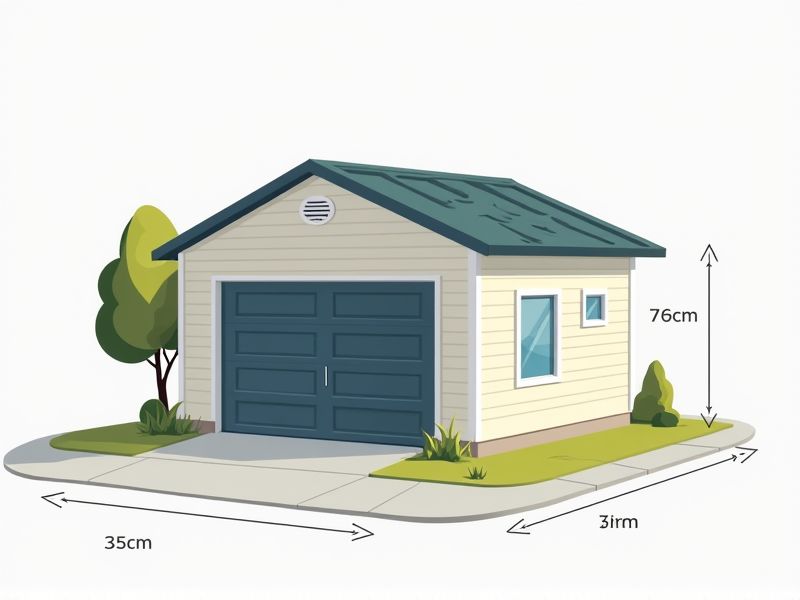
When planning for a single garage, it's important to know the standard dimensions to ensure your vehicle fits comfortably and there's adequate space for storage or movement. Typically, a single garage measures about 10 to 12 feet wide and 20 to 24 feet deep, providing ample room for most cars and small trucks. If you have a larger vehicle or need extra storage, you might consider a width of up to 14 feet or increased depth. Always double-check your car's dimensions and plan for extra walking or storage space to make your garage as functional as possible.
Width
The standard width of a single garage typically measures 3 meters (10 feet), providing ample space for most vehicles. This width allows for comfortable entry and exit without the risk of scraping the sides. When planning your garage, consider adding an additional 0.5 meters (1.5 feet) if you desire extra storage space for tools or bicycles. Ensuring the width meets standard dimensions is crucial for functionality and vehicle protection.
Depth
A standard single garage typically measures about 12 feet (3.66 meters) in width and 20 to 24 feet (6 to 7.3 meters) in depth. This depth allows for the accommodation of a vehicle while providing space for maneuvering and storage. When designing your garage, consider a depth of at least 24 feet (7.3 meters) if you plan to include shelving or other storage solutions. Ensuring this standard depth not only maximizes utility but also enhances accessibility for larger vehicles and equipment.
Height
The standard height for a single garage typically ranges between 8 to 9 feet, accommodating most vehicles. This clearance ensures that even taller SUVs or vans can enter without obstruction. If your garage includes shelves or overhead storage, consider increasing the height to 10 feet for additional utility. Always check local building regulations to ensure compliance with any specific height requirements in your area.
Door Size
A standard single garage door typically measures 8 feet wide by 7 feet high, providing ample space for most vehicles. This size accommodates various car models, ensuring you have a functional and accessible entrance. If your garage has additional features, such as storage or workspaces, consider opting for a slightly larger door, such as 9 feet wide. Ensuring compliance with local building codes is essential, as they may dictate the minimum or maximum dimensions for your garage door.
Driveway Length
A standard single garage typically measures 3 meters in width and 6 meters in length, requiring a driveway length of at least 5-6 meters for proper access and vehicle maneuverability. This ensures that your vehicle can park comfortably without obstructing the road or sidewalks. It's essential to consider local regulations, which may dictate minimum driveway dimensions to avoid issues with zoning or accessibility. Overall, a well-planned driveway enhances both functionality and curb appeal for your property.
Ceiling Clearance
A standard single garage typically has a ceiling clearance of about 8 to 9 feet (2.4 to 2.7 meters), allowing enough space for vehicles of various heights while accommodating overhead storage options. This height ensures that even larger vehicles, such as SUVs or trucks, can easily enter and exit without risk of damage. For optimal versatility, consider a garage with adjustable ceiling heights, which can provide flexibility for future usage changes. When designing or choosing a garage, ensuring adequate ceiling clearance can significantly enhance the overall functionality and value of your property.
Wall Thickness
The standard wall thickness for a single garage typically ranges between 4 to 6 inches for concrete walls, providing adequate insulation and structural integrity. For wooden garages, wall thickness may vary, with 2x4 inch framing resulting in approximately 3.5 inches of thickness, excluding the exterior siding. Insulated garages often feature walls that are at least 6 inches thick, ensuring energy efficiency while minimizing heat loss. Selecting the optimal wall thickness is crucial for durability and protection against environmental elements, enhancing the longevity of your garage.
Floor Space
A standard single garage typically measures around 12 feet by 20 feet (approximately 240 square feet), providing adequate floor space for most compact cars. This dimension accommodates not only the vehicle but also allows for additional storage, tool organization, or even a small workspace. The layout often includes features like a door width of 8 to 9 feet, ensuring easy entry and exit. Your single garage can effectively maximize utility by incorporating shelving units or cabinets along the walls, optimizing floor space while maintaining functionality.
Ventilation Requirements
Ventilation requirements for a standard single garage, typically measuring about 12x20 feet, are crucial for ensuring air quality and preventing moisture buildup. It is recommended to have at least one square foot of ventilation opening per 300 square feet of garage space, facilitating adequate airflow. Incorporating vents at both high and low points can promote cross-ventilation, enhancing energy efficiency and reducing the risk of mold or mildew. When considering the installation of exhaust fans, a minimum airflow rate of 2 to 4 air changes per hour is advisable to maintain optimal ventilation levels.
Storage Space
A standard single garage typically offers around 150 to 400 square feet of storage space, accommodating various vehicles and tools. The typical dimensions are approximately 12 feet wide by 24 feet deep, allowing room for your car and additional storage solutions. By utilizing vertical space with shelves or hooks, you can maximize your storage capabilities, often increasing functional capacity by up to 30%. Consider innovative organization systems to transform your garage into an efficient storage area that meets your needs.
